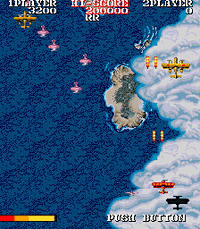|
1943 KAI - BATTLE OF MIDWAY
|
|

|

|
|
1943改
©1987 Capcom
©1991 Naxat Soft
Release : 1991-03-22 (¥7200)
HuCard (4 Mbits) NX91002
Shooter / Vertical
|
1943 Kai is a vertical shooter and conversion of Capcom's popular arcade
game originally released in 1987. This version was however developed by Naxat Soft
and this port is essentially an enhanced remake of the original game. The action takes place
during World War II and depicts the historic battle between the American and
Japanese air forces in the Pacific. The player flies a Stearman biplane fighter
plane and must destroy endless waves of enemy fighter planes, bombers and large battleships.
The Stearman is equipped with a standard machine-gun that can be upgraded in all kind of
ways. Formation of red enemy places drop special icons when defeated, and shooting at the same
icons again loops through various power-ups and items, such as POW options (extra health),
Shot Gun, 3-Ways, Super Shells, Lasers, Side Fighters or various
special items such as the Double Pill (energy boost). The trademark Capcom special
items are also scattered throughout the game, such as the Cow, the strawberry or the
Yashichi (red and white twister/wheel shaped item) which gives the
player an instant refill of energy. The second button is
also used to release super-bombs that clean up the screen in exchange of some of the plane's energy,
or make it loop in the air and avoid harmful enemy bullets. 1943-Kai features all the stages
from the arcade game, as well as an original mode and a two player option.
|
 1943 Midway Kaisen (aka 1943 The Battle of Midway) was an arcade game originally released by
Capcom in 1987. But the conversion tested here is based on an enhanced version of the game, called
1943 Kai Midway Kaisen, only released in Japan in 1988 (picture on the left). This updated version shows many
differences with the original game - players pilot a Stearman biplane fighter instead of the trademark
Lockheed P-38 Lightning, and the game introduces more exotic weapons such as lasers beams and the shot gun. The
game was ported to the PC Engine (1991) and included in the
Capcom Generation 1 - Dai 1 Shū Gekitsuiō no Jidai (aka Capcom Retro Game Collection Vol. 1)
released for the Playstation and Saturn in 1998, as well as in the Capcom Classics Collection
(Playstation 2, Xbox) in 2005, and in the Capcom Classics Collection
(aka Capcom Classics Collection Reloaded) released for the Playstation Portable in 2006.
Finally, although the PC Engine version tested here is faithful to the arcade game, it features
five additional and exclusive levels (called 'Original mode'), as well as new enemies and bosses.
1943 Midway Kaisen (aka 1943 The Battle of Midway) was an arcade game originally released by
Capcom in 1987. But the conversion tested here is based on an enhanced version of the game, called
1943 Kai Midway Kaisen, only released in Japan in 1988 (picture on the left). This updated version shows many
differences with the original game - players pilot a Stearman biplane fighter instead of the trademark
Lockheed P-38 Lightning, and the game introduces more exotic weapons such as lasers beams and the shot gun. The
game was ported to the PC Engine (1991) and included in the
Capcom Generation 1 - Dai 1 Shū Gekitsuiō no Jidai (aka Capcom Retro Game Collection Vol. 1)
released for the Playstation and Saturn in 1998, as well as in the Capcom Classics Collection
(Playstation 2, Xbox) in 2005, and in the Capcom Classics Collection
(aka Capcom Classics Collection Reloaded) released for the Playstation Portable in 2006.
Finally, although the PC Engine version tested here is faithful to the arcade game, it features
five additional and exclusive levels (called 'Original mode'), as well as new enemies and bosses.
|
|
See 1942 (Fc) for more information about the 194x series.
|
Game Staff (Copied from the end credits) :
|
Program
Y. Ochiai
Design
Blue Bird
|
|
Music
H. Matsushita
D. Morishima
|
|
Special Thanks
Otaka
Mania-Yajima
Gammer-Takahashi
©1987 Capcom
©1991 Naxat Soft
|
|
O
M
A
K
E
|
|

|
|
|
Click on picture to enlarge |
|
|
|
LK

|
|
Add your Pov here !
|
P
O
V
s
|
|
Naxat Soft did here an outstanding job. The original mode,
which kicks in right after the arcade game, is pure adrenaline. At that point,
your plane gets a massive upgrade and flies off to a new mission. The first time
I reached the original mode, I thought it would only last for one stage, but
imagine my surprise when I realized that it spanned over five levels! It is like
playing a totally different game, really - with new weapons and an amazing new
soundtrack. The only weak point of the 194X series has always been,
I think, the obvious repetitiveness of the levels which, frankly, always end up
looking the same. These extra stages are definitively the icing on the cake of
an already excellent conversion. If you're a fan of Capcom's 194X
series, then this PC Engine conversion is a must have !
|
|
|
|